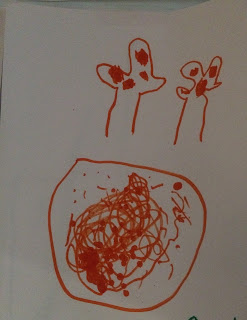This is a Tuesday
Slice of Life.
All participants are writing about one moment, one part of their day.
Slice of Life.
All participants are writing about one moment, one part of their day.
Check out the Two Writing Teachers website for many more reflections on teaching.
wa·ter·shed
ˈwôdərˌSHed,ˈwädərˌSHed/
noun
- 1.an area or ridge of land that separates waters flowing to different rivers, basins, or seas.
The Preschool Big Cats were getting ready to visit Ms. Ash's seventh-grade science class, to learn about watersheds. How to explain this phenomenon to preschoolers before heading out on our in-house field trip? Let's hand the problem back to the preschoolers and ask them if they knew the meaning. It never ceases to amaze us how fearless our preschoolers are with their explanations and wonders. Here's what the first five volunteers discerned, simply by hearing the word watershed:
“It means water floating.” (Jada)
“It’s floating in the street.” (Esther)
“Spraying on your clothes and get wet.” (Asanda)
“Water is stuck up a tree.” (Fhinn)
“When water is in a museum.” (Audrey)
We were on to something...but what?
To help clarify our understanding of watershed, we read a book that was recommended to us by the middle schoolers: All the Way to the Ocean by Joel Harper. In this book, two young friends are headed home from school when one tosses his candy wrapper down a storm drain, leading his friend to tell the harrowing story of what happens to our oceans when we toss trash on the ground.
The preschoolers were excited to hear that we would see working models of watersheds in the middle school science lab. Now we were ready to head upstairs for the demonstration!
Unlike the preschoolers, who had read one book and then walked up two flights of stairs for the demonstration, Ms. Ash’s seventh-grade scientists had been focusing on watersheds for many weeks, doing considerable research to create working models of our local Anacostia watershed. Ms. Ash shared with me privately that this scientific process had many setbacks, with students at one point throwing their hands up in defeat, unable to imagine how to effectively create the watershed for demonstration purposes. "This isn't something you can give up on," Ms. Ash explained. "You have preschool visitors coming to see the demonstration. You must persevere."
And persevere, they did!
The middle-schoolers shared a model of the Anacostia watershed with roads, homes, cars, more. They showed how the rainwater runs off across the land into the river, taking debris and trash with it. Then these middle school scientists invited the children to pour different types of liquids (regular water, “oil,” “chemicals,” other) down onto the model and watch how it moves the debris into the river. It was a real pleasure to see how kind and thought-provoking the middle schoolers were with our young ones – and a real delight to see our children so engaged. The middle schoolers seemed so mature and professional!
There were many powerful moments -
The middle-schoolers shared a model of the Anacostia watershed with roads, homes, cars, more. They showed how the rainwater runs off across the land into the river, taking debris and trash with it. Then these middle school scientists invited the children to pour different types of liquids (regular water, “oil,” “chemicals,” other) down onto the model and watch how it moves the debris into the river. It was a real pleasure to see how kind and thought-provoking the middle schoolers were with our young ones – and a real delight to see our children so engaged. The middle schoolers seemed so mature and professional!
 |
| This is one of several watershed models created |
There were many powerful moments -
- the children were super eager to participate and investigate, looking at the middle-schoolers with respect and awe. When the middle schoolers asked for six volunteers, ten children jumped up!
- one preschooler, often off-task, somewhat wild and unexpected in her movements, had an entirely different spirit in this setting - she was so focused, careful, and controlled as she poured pouring "oil" onto the watershed, following the guidance of the middle-schoolers.
- several of my more independent students sat back during this demonstration, clinging to the teaching team, content to observe the older experts...much more cautious in this new setting than in our classroom.
- one preschooler opened her eyes big and wide when one middle-schooler started conversing in Spanish with her, describing the watershed in her native language. The preschooler had a huge smile, seemingly delighted to fully understand. Another middle-schooler, lamenting being unable to communicate with the preschooler, noted "Gee, I should have worked harder in Spanish!"
That evening, I received a text from one family, reporting, "We heard a lot about your middle school field trip! Our daughter took the lessons to heart about no trash in the water! Very special day."
Yes, it really was a very special day!
My school includes preschoolers through eighth grade (ages 3-14). Something I love about my school is that we see this age range as an asset and we work to find ways for these ages to intersect. We know we have a unique opportunity to blend age groups and learn from one another.
Which brings us back to the second meaning of watershed:
- 2.an event or period marking a turning point in a course of action or state of affairs.
watershed.















